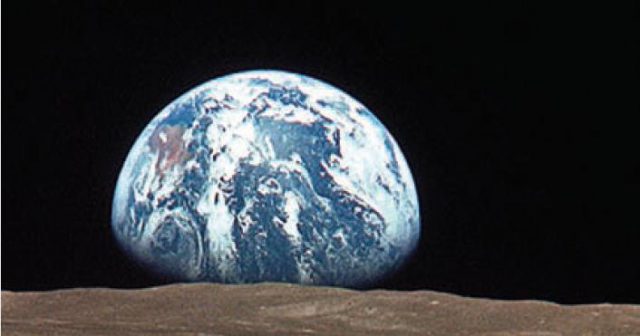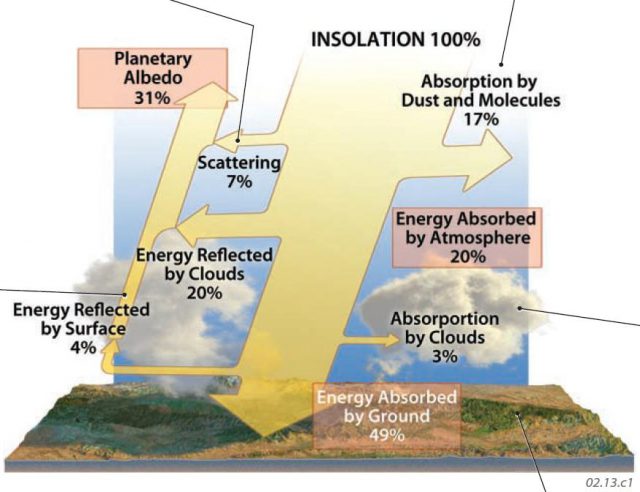How Much Insolation Reaches the Surface?
NOT ALL INSOLATION reaches Earth's surface. Much of it is intercepted (absorbed, scattered, or reflected) by the atmosphere. Measurements and models allow us to account for the destination of insolation globally. Approximately 69% of the energy arriving at the top of the atmosphere remains in the Earth's system, of which 20% is stored (absorbed) in the atmosphere and 49% is absorbed by, and heats, the Earth's surface — the rest (31%) is lost back into space. This accounting of insolation is termed the global shortwave-radiation budget.
How Is Insolation Intercepted in the Atmosphere?
The atmosphere absorbs radiation of various wavelengths, including ultraviolet (UV) light, an energetic shortwave EMR emitted by the Sun. The absorption of this harmful energy in the atmosphere allows life to exist on Earth's surface. UV is absorbed chiefly by oxygen gas, ozone, and nitrogen gas. As shown in this graph, the shortest-wavelength, highest-energy UV (UV-C) is absorbed first, followed by longer-wavelength, lower-energy UV-B. Nearly all UV-A, the longest-wavelength, least-energetic UV, is transmitted to the surface. When a wavelength of EMR passes through a substance, such as the atmosphere, without being intercepted, we say that the substance is “transparent to the energy.” The atmosphere is nearly transparent to UV-A.

Clouds can absorb, scatter, and reflect insolation, bouncing it back higher into the atmosphere and even into space. Clouds in the lower part of the troposphere, low-level clouds, can be highly reflective, like the ones shown here. The dark underside of the clouds indicates that little light is transmitted.

Clouds higher in the atmosphere, such as these wispy cirrus clouds, are typically less reflective, but still reflect about 50% of insolation striking them. These high-level clouds occur in the middle to upper troposphere and are typically composed of ice crystals, unlike low-level clouds, which contain mostly water drops.

What Happens to Insolation That Reaches Earth's Surface?
Earth's surface is diverse in its topography, rocks, soil, bodies of water, types of vegetation, and amount of human development. Each type of surface material has certain colors and other characteristics, so some surfaces reflect relatively little insolation and absorb much heat, while others reflect most insolation and absorb less heat.
1. The Apollo astronauts saw the Earth rise above the Moon's horizon. The human eye is only sensitive to EMR in the visible (0.4 – 0.7 mm) wavelengths, and the Earth emits most of its energy at wavelengths 20 times longer than this (infrared). What the astronauts saw was visible light originating from the Sun and reflecting from the Earth. All objects reflect some insolation, and the percentage of insolation that is reflected by an object is termed its albedo. Albedo varies from 0% for a theoretical black object that reflects no light to 100% for a perfectly white, smooth one; no common objects have these end-member values. The average albedo for the entire Earth-ocean-atmosphere system is 31%.

2. Different land surfaces have different albedos. When humans use the land surface, they generally change the albedo compared to its natural state, modifying the energy balance, with local and perhaps regional implications. Examine the albedo values for different types of land cover and think how changes in the land cover would affect the energy balance.

What Percentage of Insolation Goes Where?
We can measure and model how much insolation is intercepted in the air versus how much reaches the surface. Some insolation that reaches the surface is reflected upward into the atmosphere, and some of this reflected energy goes all the way back into space. Most energy is absorbed by the water, land, and vegetation. The figure below shows the global shortwave-radiation budget — how much insolation goes where, a key component of the global energy balance.
1. We begin by considering the total amount of insolation arriving at the top of the atmosphere as being represented as 100%. Then, we can examine what percentages of this total amount end up where. The left side of this figure depicts reflection and scattering of insolation, whereas the right side represents absorption.
2. Scattering by various air components (gas molecules, dust, etc.) returns 7% of total insolation back to space. Such scattering causes blue skies, red sunsets, and red sunrises, and is what illuminates the surface in shady areas and during heavy overcast days. Scattering decreases the amount of insolation that reaches the surface.
3. The amount of energy reflected by clouds is variable and controlled by many complex factors. Different types of clouds have different albedos, and some lower-level clouds are obscured below other, higher clouds. The location of a cloud is also important — tropical clouds receive more direct overhead sunlight and so have more available insolation to reflect, whereas low clouds over the poles receive little direct light, or no light at all during winter. Also, the amount of the world covered by clouds varies, depending on the season and other aspects of weather. Considering all the factors, clouds on average reflect 20% of the planet's total insolation back to space.

4. Chemical constituents of the atmosphere, such as O2 and N2 gas, absorb EMR of various wavelengths, amounting to 17% of the total insolation. Events on Earth's surface may cause considerable changes in the number of aerosols in the troposphere. Volcanic eruptions emit gases, volcanic ash, and other aerosols into the atmosphere, and these effects persist for several years. These additions increase the amount of absorption in the atmosphere.
5. Clouds absorb only a small percentage of insolation, about 3% of total insolation. The complex interaction between reflection, scattering, and absorption by various layers of clouds makes their impact on climate difficult to quantify — the net effect of clouds is one of the most difficult aspects to represent in global climate models. Some types of clouds tend to hold in heat, warming the surface, whereas others have an overall cooling effect.
6. Earth's surface albedo is fairly low but varies widely. Snow is highly reflective (high albedo), but many rocks are dark (low albedo) and rough (increasing the amount of scattering). Water generally has a lower albedo than land, and more than 70% of the Earth is covered with water. Due to reflection, scattering, and absorption in the atmosphere, only 53% of insolation reaches Earth's surface. But 4% of this energy is reflected back to space once it hits the surface, leaving 49% to be absorbed.
7. So of the total insolation, 20% is converted to sensible heat or latent heat after absorption in the atmosphere, causing an increase in temperature or a change in state (mostly evaporation of water), respectively. A total of 49% of the insolation is retained by the land, as what is called ground heat. The remaining 31% is reflected back into space, accounting for the remainder of the 100% of insolation (20% + 49% + 31% = 100%).
Changing the Global Radiation Budget

In June 1991 Mount Pinatubo in the Philippines erupted, throwing volcanic ash and gases up to 34 km into the troposphere and stratosphere. The ash circled the Earth, reducing insolation by about 1 watt per square meter (W/m2), and cooling global temperatures 0.5 C°. The image to the right shows, in red, the amount of dust circulating around the tropical regions of the world the following December (more than a half year later). The eruption was also accompanied by a decrease in global vegetation, as measured by satellite, suggesting extra absorption of insolation by volcanic ash. The effects lasted for about two years until the ash either fell out of the atmosphere or was washed out by precipitation.
